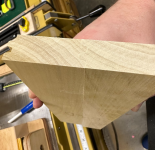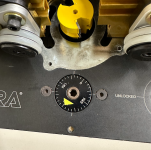ryanjg117
Member
- Joined
- May 18, 2015
- Messages
- 328
Router bit I am using:https://www.ebay.com/itm/115797974586
I won’t confess how much time I spent today fiddling with this bit to get it dialed in (complicated by the discovery that it was slowly lifting out of the router table collet while in use, a bit concerning). After reefing on the collet with two beefy wrenches, I’m confident it will stay put.
I have fence set to the inside-most cutter and have micro adjusted it perfect. Through plenty of test cuts, I also have the height set perfectly.
However, I can’t get the joint to close up. I can tell the surfaces are coplanar, but there’s a 1/32” gap that I can’t close even with heavy clamping force.
[attachimg=1]
To me, it looks like the tongue is too thick for the groove. I’m thinking at this point it’s probably a defective bit, and I should just go bite the bullet on the $60 Freud equivalent, but just wanted a quick sanity check that I’m doing something wrong.
Adjusting the fence further forward or back doesn’t help.
I won’t confess how much time I spent today fiddling with this bit to get it dialed in (complicated by the discovery that it was slowly lifting out of the router table collet while in use, a bit concerning). After reefing on the collet with two beefy wrenches, I’m confident it will stay put.
I have fence set to the inside-most cutter and have micro adjusted it perfect. Through plenty of test cuts, I also have the height set perfectly.
However, I can’t get the joint to close up. I can tell the surfaces are coplanar, but there’s a 1/32” gap that I can’t close even with heavy clamping force.
[attachimg=1]
To me, it looks like the tongue is too thick for the groove. I’m thinking at this point it’s probably a defective bit, and I should just go bite the bullet on the $60 Freud equivalent, but just wanted a quick sanity check that I’m doing something wrong.
Adjusting the fence further forward or back doesn’t help.




